Yarrow – The “Plant Doctor” for Your Yard and Garden
This post may contain affiliate links. Read my full disclosure here.
Common yarrow, Achillea millefolium, is a wonderfully useful herb for humans and makes a great companion plant. We’ll share how to find it (or grow it) and how it’s used.
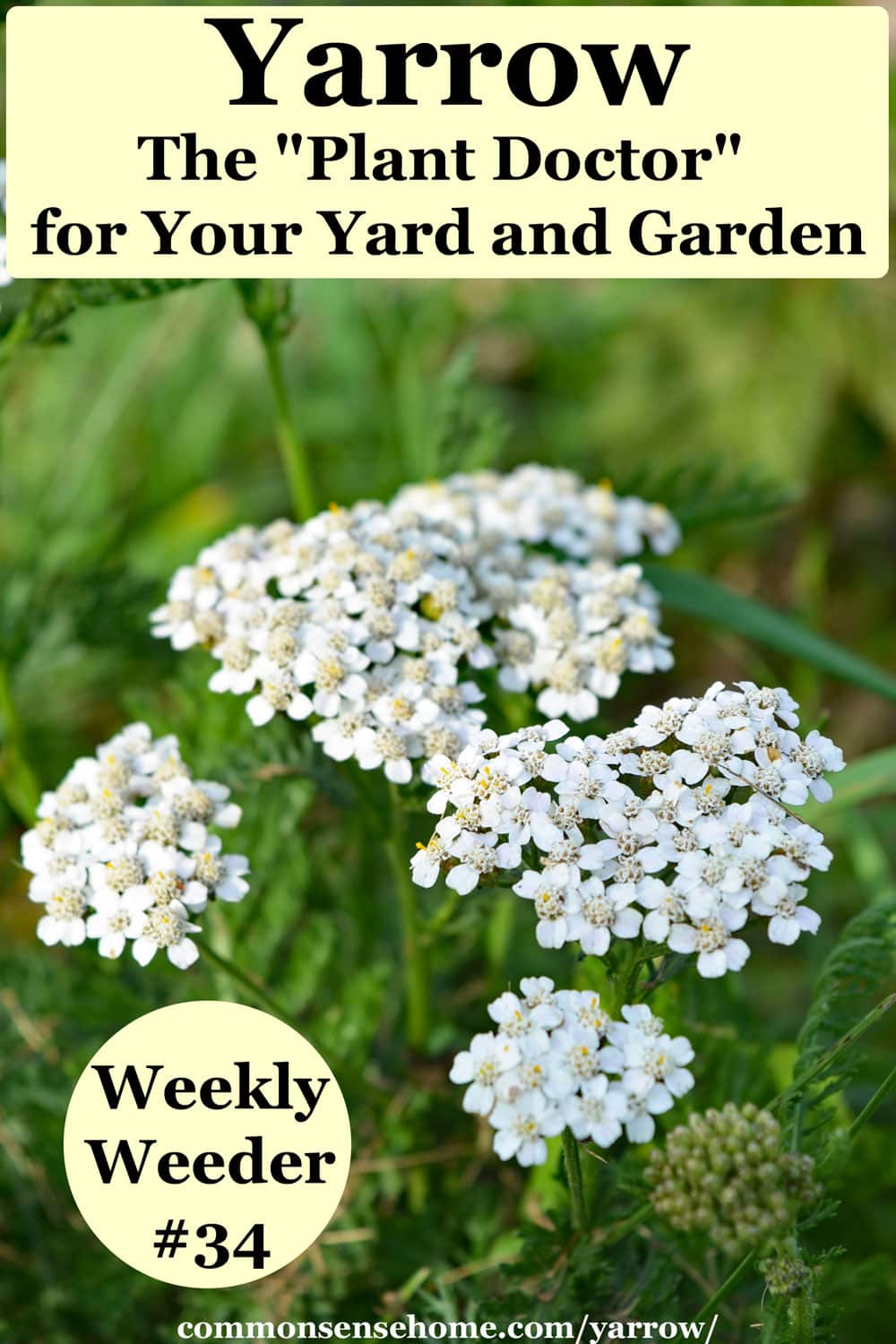
What is Yarrow Used for?
In the garden, yarrow:
- Deters pests with its strong scent and flavor
- Increases nutrient availability by drawing up minerals from deep in the soil
- Attracts pollinators with its abundant composite flowers
- Naturally increases the essential oil content of nearby plants
Achillea millefolium is also edible and medicinal. The flavor is strong, so a little goes a long way.
Common yarrow leaves can be used for tea, or dried and used as a spice. Young leaves can be added to salad or boiled for greens.
Apparently, it’s becoming popular with some chefs, as can be seen from this recipe for Shrimp with Yarrow and Lemon. Yarrow is a a time honored bitter for use in beer making.
Medicinal uses of yarrow include:
- Stops external and internal bleeding (styptic)
- Fever reducer
- Eases blood congestion
- Provides pain relief and reduces inflammation
- Antimicrobial properties
- Relieves sore throat
- Treats minor skin ailments such as sunburn, bug bites and rash
- Reduces hemorrhoidal swelling and varicose veins
- Stomach cramp relief
- Improves circulation
Not recommended for use if you are nursing or pregnant. Do not use if you have epilepsy, or are on anticoagulants or high blood pressure medication.
Some people may have an allergic reaction to this plant, especially if you are sensitive to members of the daisy family. The bruised leaves may cause contact dermatitis in some people.
Always exercise caution when using any wild plants and make sure you have positively identified the plant.
Where does yarrow grow best?
Common yarrow is native to North American and Eurasia and is found throughout much of the world. (See the USDA range map for Achillea millefolium here.)
It prefers full sun and well drained soil, and can be found along roadsides and ditches, in prairies, in gardens and other disturbed soils.
It is drought tolerant, and doesn’t mind poor soil. In fertile soil it spreads like wildfire, so don’t over-fertilize if you grow yarrow in your garden.
I decided to plant yarrow because of its medicinal properties. It quickly jumped out of the tidy herb bed designated for it, and now roams wild throughout my garden, in my lawn and all over our property.
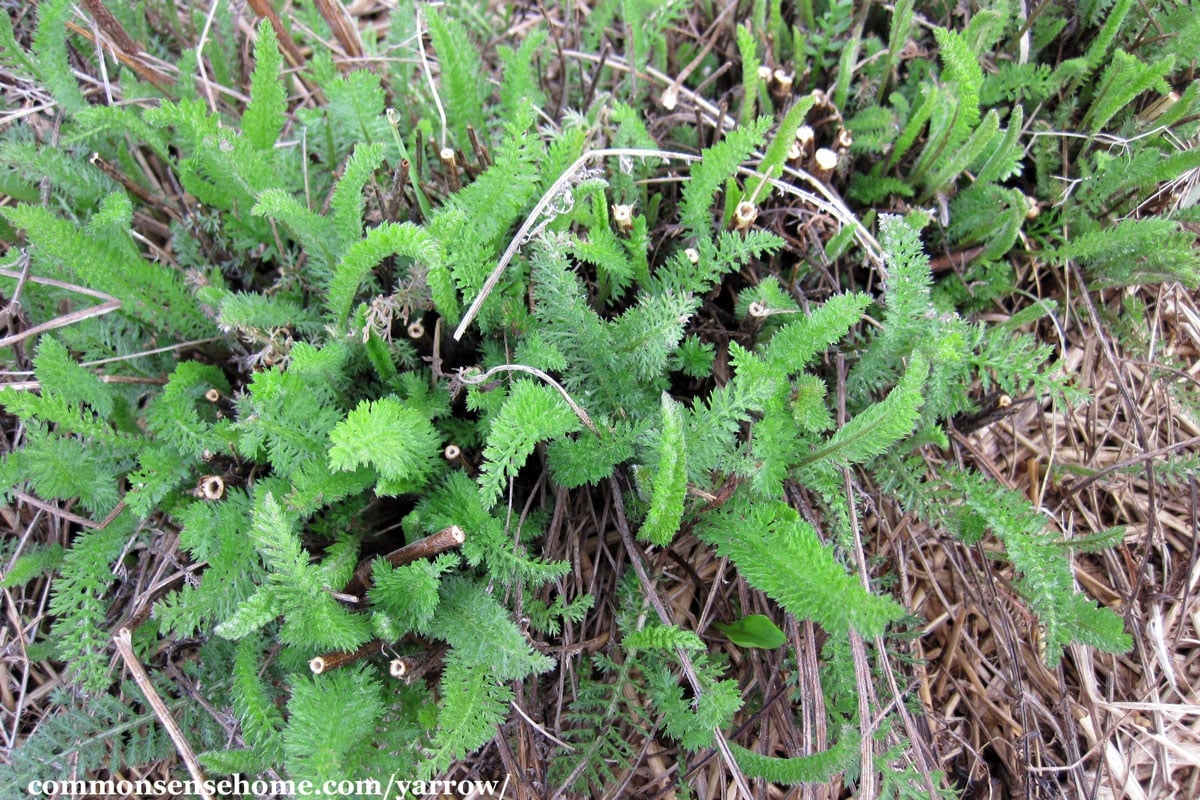
Plant Characteristics
Common yarrow is a perennial that grows in low clumps of fern-like greenery close to the ground with upright flower stalks. It spreads via rhizomes, and is also readily propagated by seed.
The plant grows from 1-3 feet tall (30-90 cm). Leaves are fern-like, about 6″ (15 cm) long. They are larger at the base and progressively smaller up the stem.
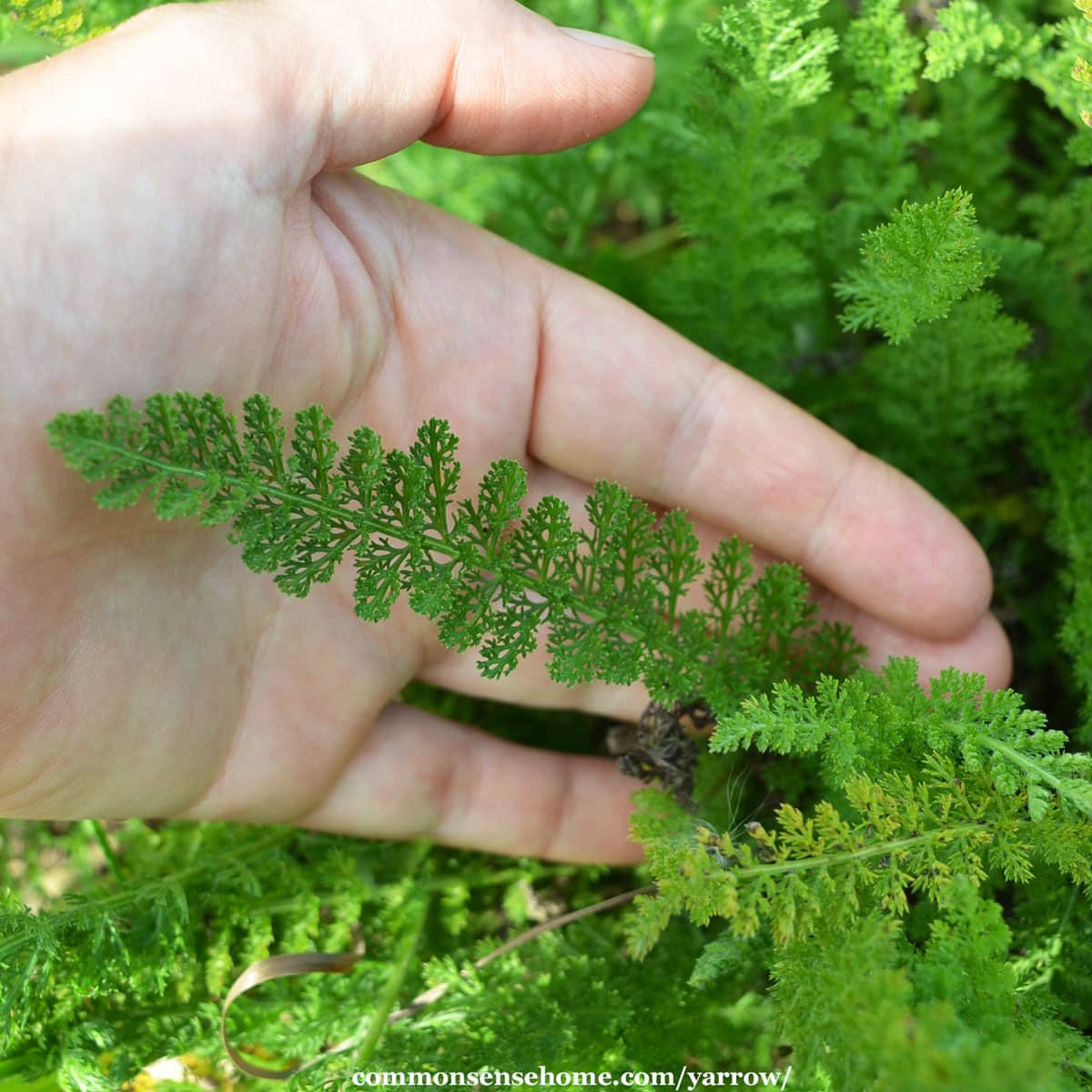
The entire plant has a strong musky scent when crushed, similar to sage. Some people use the flowers and silvery foliage as a ground cover in dry, low traffic areas with poor soil.
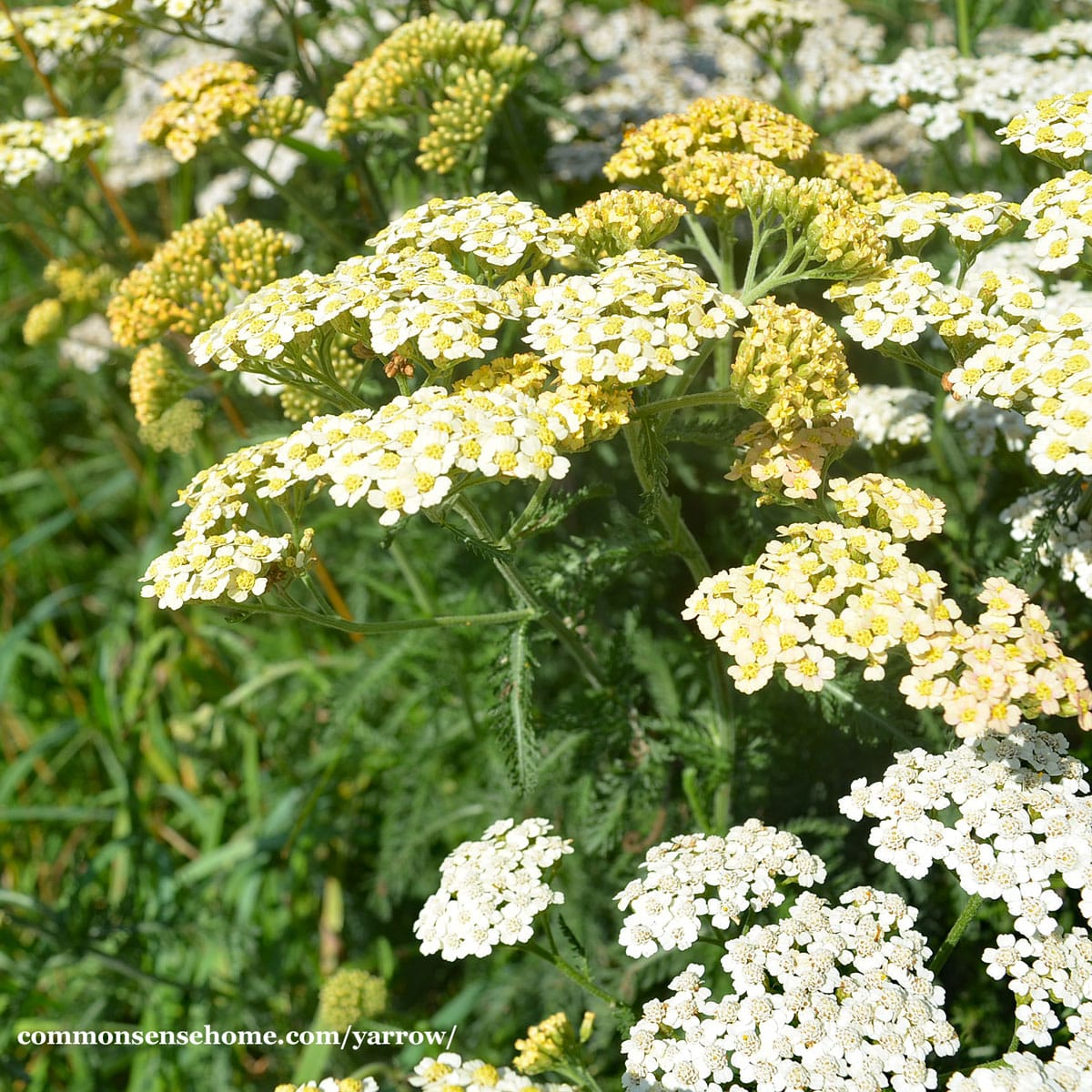
White and pink flowers are the most common. Other colors include yellow and red flowers. The flower clusters are are small, about 2-4″ (5-10 cm), and are made up of around 5 tiny (1/4″ (.6 cm)) flowers.
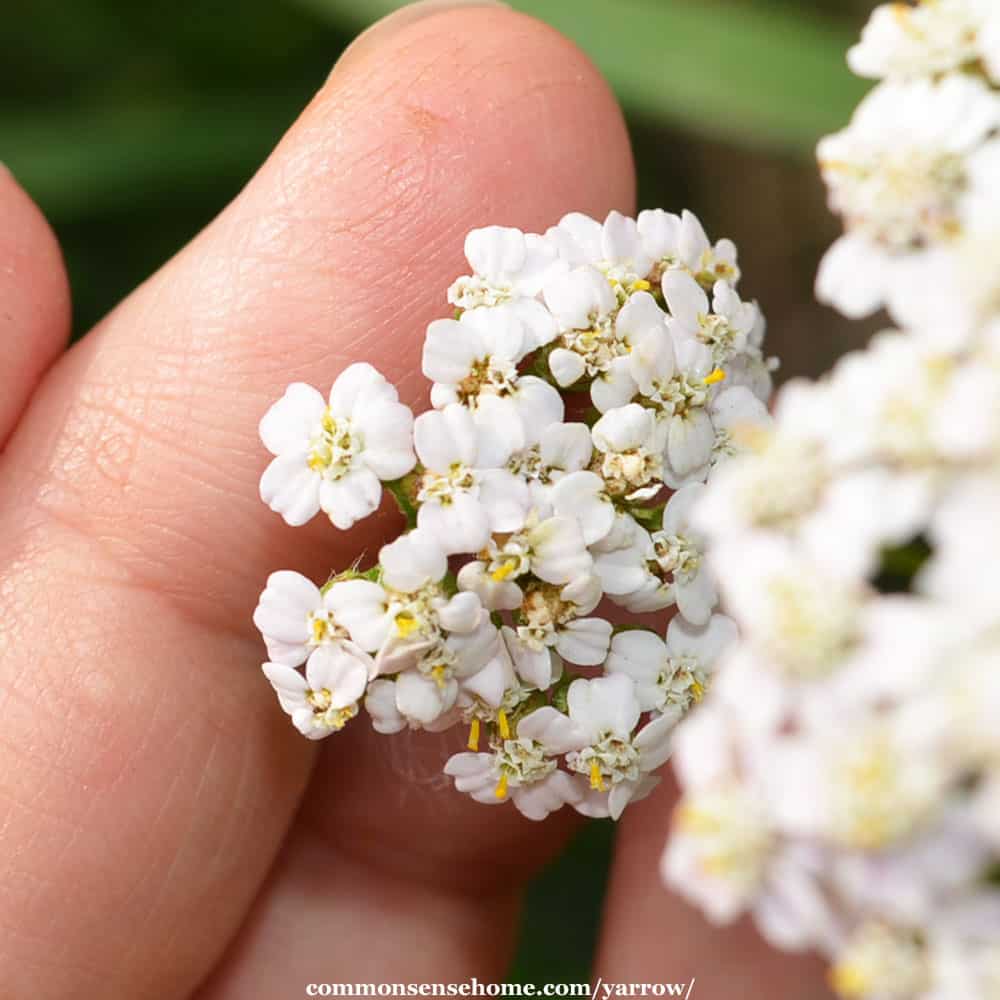
Yarrow blooms in summer and fall. Dead head (remove fading flower heads) for a longer display of color.
If you plant yarrow in the garden
Space plants around 1 to 3 feet apart. Avoid damp areas and soggy soil. I keep my yarrow at the edge of garden beds because it loves to spread.
The plants are tough and almost carefree, though they may get mildew in humid conditions. Spittlebugs use them, but they don’t tend to do much damage.
Rabbits and deer don’t enjoy the taste of yarrow, so the flowers are safe from furry predators.
Medicinal Use of Yarrow
Use yarrow fresh, dried, in tincture or in salve. The best time to harvest yarrow is when the flowers are in bloom and the leaves are green and lush.
Fresh leaves can be harvested at any time, but the flowering plant is the most potent. Select white or pink flowered plants for medicinal use. Yellow flowers and other colors may not be as medicinal.
Would you like to save this?

To dry yarrow, select long stems of leaves and flowers. Hang dry, place in a brown paper bag, or use a commercial dehydrator or drying screen.
If using a dehydrator, separate leaves and flowers from the stems for quicker drying.
Yarrow Tea
Add one heaping teaspoon of dried yarrow to a mug of boiling water. Cover and infuse for 10 minutes. Strain and drink hot, adding a bit of honey if preferred.
Backyard Medicine suggests one mug of tea every two hours for colds and fever until symptoms improve. Follow up with three cups per day, until well.
Fresh Leaves for Wounds and Nosebleeds
Crush the fresh leaves and use them to stop bleeding in the case of a nosebleed or cut. Twist the leave into a plug and insert in the nose until bleeding stops.
For wounds, crush or chop the leaves to release the juices. Secure the plant material on the wound with a bandage.
Dried Leaves for Styptic and Salves
Once dried and powdered, the leaves make an excellent styptic for cuts and scrapes. Just sprinkle the powder lightly over the wound to stop bleeding.
The Backyard Herbal Apothecary offers a simple recipe for Yarrow All-Purpose Wound Salve. (You can get your copy of this great book here.)
Ingredients
- 1/2 cup dried yarrow leaf and flower
- 1 cup base oil blend of your choice (coconut oil and olive oil are two of the most shelf stable oils)
- 2-4 tablespoons beeswax pastels or chopped beeswax
Directions
Infuse the yarrow into the oil. (See How to Infuse Herbs for more information.) Strain the oil through muslin or cheese cloth.
Place the oil in a double boiler or heavy bottom pot. Add the beeswax and heat gently until the beeswax is completely melted.
Pour into four 2 ounce containers (or containers of your choice). Allow to cool before sealing the containers. Use within one year.
Use this salve for minor cuts, scrapes, bug bites and other skin irritations.
For those who like digging into scientific research, check out “A review on phytochemistry and medicinal properties of the genus Achillea“. They get into detailed discussion of flavinoids, coumarins, terpenoids and other wonders of the Achillea species.
Other Common Names for Achillea millefolium
Other names of Achillea millefolium include milfoil, Old Man’s Pepper, Soldier’s Woundwort, Knight’s Milfoil, Herbe Militaris, Thousand Weed, Nose Bleed, Carpenter’s Weed, Bloodwort, Staunchweed, Sanguinary, Devil’s Nettle, Devil’s Plaything, Bad Man’s Plaything, and Yarroway. (From A Modern Herbal.)
The genus name, Achillea, comes from the legend of Achilles. Achilles used the plant to bleeding wounds during the Trojan War.
The species name, millefolium, means “thousand leaf”. It refers to the many divisions in the leaf that make one leaf look like many.
More Herbal Resources
This post is #34 in the Weekly Weeder series. Other posts in the series include:
- Recommended Wildcrafting Reference Books – Weekly Weeder #1
- Stinging Nettle – One of Most Useful Wild Plants – Weekly Weeder #16
- Broadleaf Plantain – The “Weed” You Won’t Want to Be Without – Weekly Weeder #14
Recommended Resources
Edible & Medicinal wild Plants of Minnesota and Wisconsin
For more in depth plant studies, consider The Herbal Academy. The Herbarium is a great place for research, plus they have online courses from beginner to advanced.

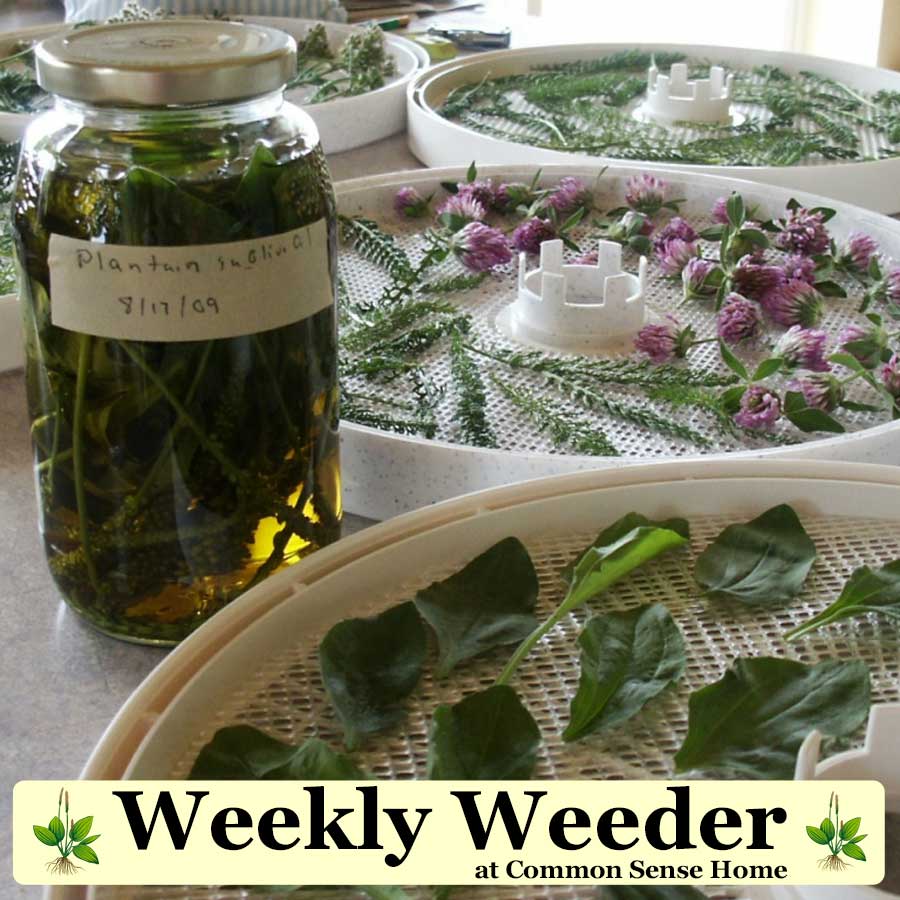
Originally posted in 2012, last updated in 2020.

I started some yarrow seedlings this spring. When I transplanted them outside, some critter kept digging them up overnight! After 2 or 3 times of tenderly replacing them and tucking them back into the ground, I finally put some plastic forks around them tines-up. This helped some, but only 1 of the insulted plants survived the ordeal. Said critter also dug up a cosmos, and my dill plant disappeared that 1st night. Any idea who the culprit might have been?
Without spotting the perpetrator, I’m guessing, but it could be a ground hog. They are often active at night, and snack on a wide array of plants.
Wild rabbits tend to avoid herbs, at least in my gardens. Ground squirrels (pocket gophers) are usually active during the day, too, to they’d be more obvious. The same goes for squirrels and chipmunks. Skunks like to dig for grubs in the soil, so they’ll disturb plantings, but don’t often eat the plants themselves. Racoons usually wait until there’s something big and tasty that you’re almost ready to harvest, then chew on it the night before you pick. Mice and rats like fruit and veggies better than plants.
You can keep an eye out for tracks and scat, or set up a game cam (like this one) to monitor your garden at night.
Thanks for sharing your knowledge. Even in an urban environment there is a great deal of practical knowledge in what you right.
Thanks. Jeremy. I’m partial to rural life, but we still all need to cover the basics, wherever we live.
Love all your content; easy to read, understand, and take the next steps on my own.
I’m glad you find it helpful. Tell your friends! We’re being bumped out of search results by Big Pharma.
Please keep up the amazing work. I love the info you provide about herbs.
Catherine
Thanks, Catherine.